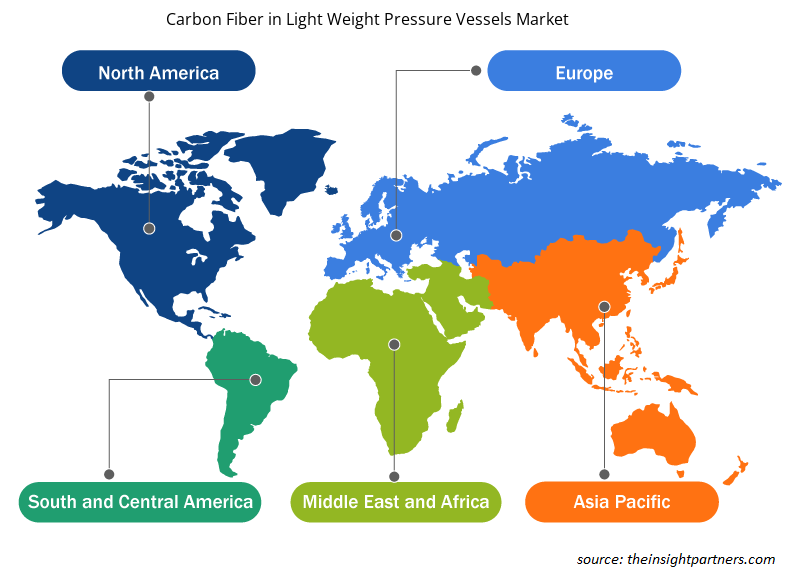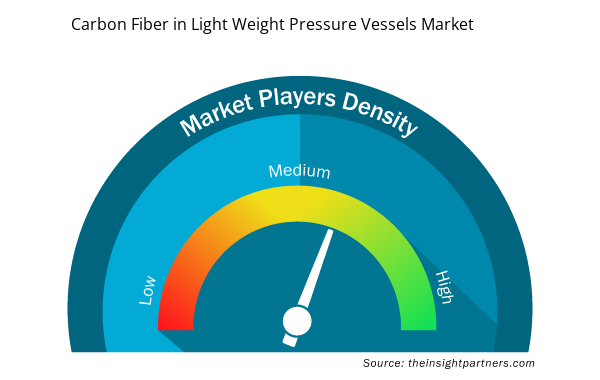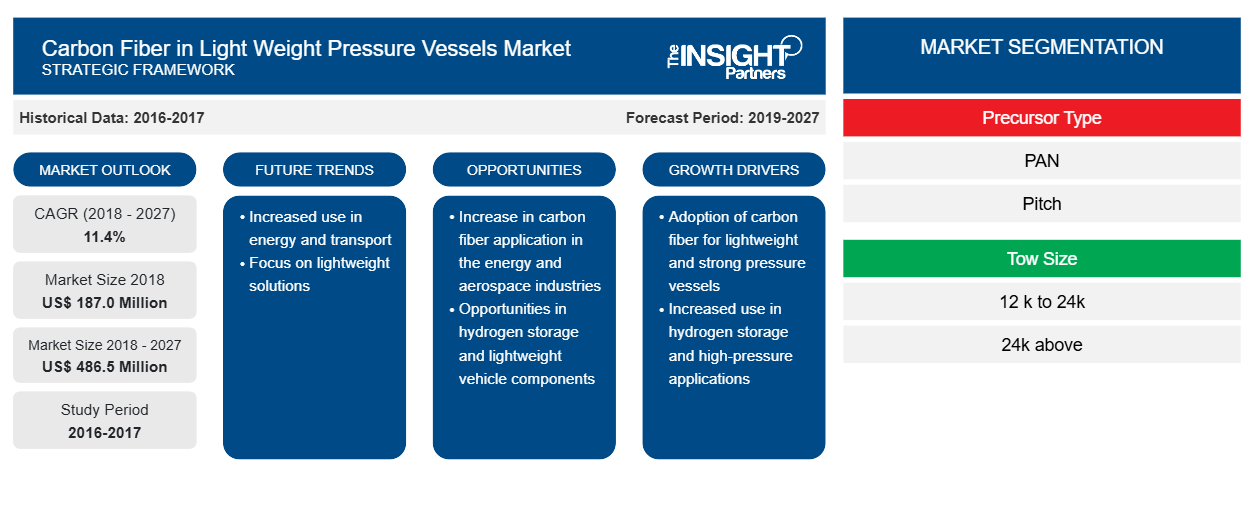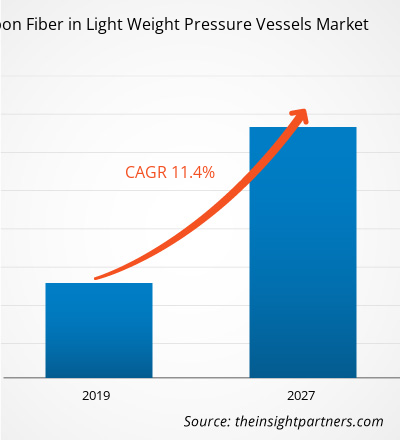Der globale Markt für Kohlefasern in leichten Druckbehältern belief sich im Jahr 2018 auf 187,0 Millionen US-Dollar und dürfte im Prognosezeitraum 2019–2027 mit einer durchschnittlichen jährlichen Wachstumsrate von 11,4 % wachsen und bis 2027 einen Wert von 486,5 Millionen US-Dollar erreichen.
Die Region APAC ist die am schnellsten wachsende Region für Druckbehälter auf Kohlenstofffaserbasis, was auf die wachsende Bevölkerung und die wachsenden Umweltbedenken von Regierungen in Ländern wie Indien, China und Japan sowie den zunehmenden Fokus auf energieeffiziente und umweltfreundliche CNG-Fahrzeuge zurückzuführen ist. Darüber hinaus wird erwartet, dass die steigende Nachfrage aus der Automobilindustrie das Wachstum des Marktes für Kohlenstofffasern in leichten Druckbehältern in der Region vorantreiben wird.
Markteinblicke
Steigende Anforderungen aus der Automobil- und Industriebranche bieten Chancen für das Wachstum des Marktes für Kohlenstofffasern in leichten Druckbehältern
Die Kohlenstofffaser bietet einen hohen Modul und eine hohe spezifische Festigkeit, eine hohe Dauerfestigkeit, eine hohe Steifigkeit, eine hohe Druckfestigkeit, einen niedrigen Wärmeausdehnungskoeffizienten, Korrosionsbeständigkeit und andere vorteilhafte Eigenschaften, die sie für Druckbehälter in der Automobilindustrie und anderen industriellen Anwendungen nützlich machen. Darüber hinaus wird erwartet, dass die steigende Nachfrage nach Leichtbaumaterialien sowie staatliche Initiativen zur Reduzierung der Schadstoffemissionen und zur Steigerung der Kraftstoffeffizienz den Markt für Kohlenstofffasern in leichten Druckbehältern in der Automobilindustrie ankurbeln werden.
Passen Sie diesen Bericht Ihren Anforderungen an
Sie erhalten kostenlos individuelle Anpassungen an jedem Bericht, einschließlich Teilen dieses Berichts oder einer Analyse auf Länderebene, eines Excel-Datenpakets sowie tolle Angebote und Rabatte für Start-ups und Universitäten.
- Holen Sie sich die wichtigsten Markttrends aus diesem Bericht.Dieses KOSTENLOSE Beispiel umfasst eine Datenanalyse von Markttrends bis hin zu Schätzungen und Prognosen.
Die zunehmende Verwendung von Druckbehältern auf Kohlenstofffaserbasis in Brennstoffzellenfahrzeugen wird Wachstumschancen für den globalen Markt für Kohlenstofffasern in leichten Druckbehältern schaffen
Auf dem globalen Markt für Kohlefasern in leichten Druckbehältern wird mit einer steigenden Nachfrage nach Kohlefasern in dichten Behältern zur Speicherung von Wasserstoffgas unter hohem Druck gerechnet. Kohlefasern gelten als die beste Option für die Herstellung zuverlässiger und sicherer Druckbehälter, da sie dem hohen Druck von Wasserstoff standhalten können. Aus diesem Grund beteiligen sich die globalen Automobilhersteller zunehmend an der Entwicklung von Brennstoffzellenfahrzeugen, und die jeweiligen nationalen Regierungen unterstützen den Bau der Infrastruktur für die Produktion von Brennstoffzellenfahrzeugen.
Einblicke in Vorläufer
Auf der Grundlage von Vorläufern wurde der globale Markt für Kohlefasern in leichten Druckbehältern in Polyacrylnitril (PAN) und Pech segmentiert. Das Segment Polyacrylnitril (PAN) war der führende globale Markt für Kohlefasern in leichten Druckbehältern. Polyacrylnitril (PAN) ist eine Kohlefaser, die etwa 68 % Kohlenstoff enthält und eine der am häufigsten verwendeten Vorläufer für Kohlefasern ist. PAN wird durch den Polymerisationsprozess aus Acrylnitril (AN) durch die üblicherweise verwendeten Inhibitoren wie Azoverbindungen und Peroxide polymerisiert. Die steigende Nachfrage nach Kohlefasern in leichten Druckbehältern hat zu einem Anstieg der Herstellung und Produktion von PAN geführt, da es eine der am häufigsten verwendeten Vorläufer ist.
Einblicke in die Schlepptaugröße
Der globale Markt für Kohlefasern in leichten Druckbehältern wurde nach Fasergröße in 12k bis 24k und über 24k segmentiert. Das Segment 12k bis 24k hatte den größten Anteil am globalen Markt für Kohlefasern in leichten Druckbehältern. Die schwere und steife Beschaffenheit von Kohlefasern der Fasergröße 12k bis 24k erweist sich als vorteilhaft für militärische und wissenschaftliche Geräteanwendungen, die ein wichtiger Faktor für das Wachstum und die Verbreitung von Kohlefasern der Fasergröße 12k bis 24k auf der ganzen Welt sind. Einige der wichtigsten Akteure, die Kohlefasern der Fasergröße 12k bis 24k herstellen, sind Toray Composite Materials America, Inc., Teijin Limited, SGL Group und viele andere.
Regionale Einblicke in den Markt für Kohlefasern in leichten Druckbehältern
Die regionalen Trends und Faktoren, die den Markt für Kohlefaser in leichten Druckbehältern während des gesamten Prognosezeitraums beeinflussen, wurden von den Analysten von Insight Partners ausführlich erläutert. In diesem Abschnitt werden auch die Marktsegmente und die Geografie für Kohlefaser in leichten Druckbehältern in Nordamerika, Europa, im asiatisch-pazifischen Raum, im Nahen Osten und Afrika sowie in Süd- und Mittelamerika erörtert.

- Erhalten Sie regionale Daten zum Markt für Kohlefasern in leichten Druckbehältern
Umfang des Marktberichts zu Kohlefasern in leichten Druckbehältern
| Berichtsattribut | Details |
|---|---|
| Marktgröße im Jahr 2018 | 187,0 Millionen US-Dollar |
| Marktgröße bis 2027 | 486,5 Millionen US-Dollar |
| Globale CAGR (2018 - 2027) | 11,4 % |
| Historische Daten | 2016-2017 |
| Prognosezeitraum | 2019–2027 |
| Abgedeckte Segmente | Nach Vorläufertyp
|
| Abgedeckte Regionen und Länder | Nordamerika
|
| Marktführer und wichtige Unternehmensprofile |
|
Marktteilnehmerdichte: Der Einfluss auf die Geschäftsdynamik
Der Markt für Kohlenstofffasern in leichten Druckbehältern wächst rasant, angetrieben durch die steigende Nachfrage der Endverbraucher aufgrund von Faktoren wie sich entwickelnden Verbraucherpräferenzen, technologischen Fortschritten und einem größeren Bewusstsein für die Vorteile des Produkts. Mit steigender Nachfrage erweitern Unternehmen ihr Angebot, entwickeln Innovationen, um die Bedürfnisse der Verbraucher zu erfüllen, und nutzen neue Trends, was das Marktwachstum weiter ankurbelt.
Die Marktteilnehmerdichte bezieht sich auf die Verteilung der Firmen oder Unternehmen, die in einem bestimmten Markt oder einer bestimmten Branche tätig sind. Sie gibt an, wie viele Wettbewerber (Marktteilnehmer) in einem bestimmten Marktraum im Verhältnis zu seiner Größe oder seinem gesamten Marktwert präsent sind.
Die wichtigsten Unternehmen auf dem Markt für Kohlefasern in leichten Druckbehältern sind:
- HYOSUNG CORPORATION
- Solvay
- Formosa Plastics Corporation
- Toray Industries, Inc
- Teijin Limited
Haftungsausschluss : Die oben aufgeführten Unternehmen sind nicht in einer bestimmten Reihenfolge aufgeführt.

- Überblick über die wichtigsten Akteure auf dem Markt für Kohlefaser in leichten Druckbehältern
Fusionen und Übernahmen, die Entwicklung neuer Produkte in Investitionsszenarien und andere wurden als die am häufigsten angewandten Strategien auf dem globalen Markt für Kohlefasern in leichten Druckbehältern beobachtet. Nachfolgend sind einige der jüngsten Entwicklungen auf dem globalen Markt für Kohlefasern in leichten Druckbehältern aufgeführt:
- 2019: Teijin Limited hat der Übernahme der Renegade Materials Corporation (Renegade) zugestimmt, mit der Teijin sein Geschäft mit Kohlefasern und Zwischenmaterialien stärken möchte, um seine Position als führender Anbieter von Lösungen für die Luft- und Raumfahrtindustrie zu behaupten.
- 2018: Toray Industries Inc. schloss eine Vereinbarung mit Koninklijke Ten Cate BV über den Kauf sämtlicher Anteile seiner Tochtergesellschaft TenCate Advanced Composites Holding BV. Diese Übernahme sollte erhebliche Synergien durch die Kombination der Produktpalette der Tochtergesellschaft mit der Palette an Kohlefaser- und Polymertechnologien hervorbringen.
- 2017: Hexcel gründete MAXIM, ein neues, mit 7,4 Millionen Pfund staatlich gefördertes Unternehmen für die Forschung und Entwicklung von Kohlefasergeweben, und erweiterte seine Produktionsstätte in Leicester.
GLOBALE MARKTSEGMENTIERUNG FÜR KOHLEFASER IN LEICHTGEWICHTIGEN DRUCKBEHÄLTERN
Von Precursors
- Polyacrylnitril (PAN)
- Tonhöhe
Nach Schleppgröße
- 12.000 bis 24.000
- Über 24k
Nach Geografie
Nordamerika
- UNS
- Kanada
- Mexiko
Europa
- Deutschland
- Frankreich
- Italien
- Vereinigtes Königreich
- Russland
- Restliches Europa
Asien-Pazifik
- Australien
- China
- Indien
- Japan
- Südkorea
- Restlicher Asien-Pazifik-Raum
Rest der Welt
- Brasilien
- Argentinien
- Restliches Südamerika (SAM)
Firmenprofile
- HYOSUNG CORPORATION
- Solvay
- Formosa Plastics Corporation
- Toray Industries, Inc
- Teijin Limited
- SGL Carbon
- Mitsubishi Chemical Corporation
- Kureha Corporation
- Hexcel Corporation
- Dowaksa
- Historische Analyse (2 Jahre), Basisjahr, Prognose (7 Jahre) mit CAGR
- PEST- und SWOT-Analyse
- Marktgröße Wert/Volumen – Global, Regional, Land
- Branche und Wettbewerbsumfeld
- Excel-Datensatz


- Collagen Peptides Market
- Rare Neurological Disease Treatment Market
- Fertilizer Additives Market
- Animal Genetics Market
- Saudi Arabia Drywall Panels Market
- Transdermal Drug Delivery System Market
- Hair Extensions Market
- Terahertz Technology Market
- Bioremediation Technology and Services Market
- Battery Testing Equipment Market

Report Coverage
Revenue forecast, Company Analysis, Industry landscape, Growth factors, and Trends

Segment Covered
This text is related
to segments covered.

Regional Scope
North America, Europe, Asia Pacific, Middle East & Africa, South & Central America

Country Scope
This text is related
to country scope.
Häufig gestellte Fragen
The heavy and stiff nature of 12k to 24k tow size carbon fibers prove to be beneficial in the military and scientific equipment.
The Polyacrylonitrile (PAN) is commonly used precursor for carbon fiber in a lightweight pressure vessels industry. It contains approximately 68% of carbon and is one of the most widely used precursors for carbon fibers.
APAC region is the fastest-growing region for carbon fiber-based pressure vessels, owing to increasing population and growing environmental concerns governments in countries such as India, China, and Japan coupled with the rising focus on energy-efficient and environmental friendly CNG vehicles.
Trends and growth analysis reports related to Chemicals and Materials : READ MORE..
The List of Companies
- HYOSUNG CORPORATION
- Solvay
- Formosa Plastics Corporation
- Toray Industries, Inc
- Teijin Limited
- SGL Carbon
- Mitsubishi Chemical Corporation
- Kureha Corporation
- Hexcel Corporation
- Dowaksa
The Insight Partners performs research in 4 major stages: Data Collection & Secondary Research, Primary Research, Data Analysis and Data Triangulation & Final Review.
- Data Collection and Secondary Research:
As a market research and consulting firm operating from a decade, we have published and advised several client across the globe. First step for any study will start with an assessment of currently available data and insights from existing reports. Further, historical and current market information is collected from Investor Presentations, Annual Reports, SEC Filings, etc., and other information related to company’s performance and market positioning are gathered from Paid Databases (Factiva, Hoovers, and Reuters) and various other publications available in public domain.
Several associations trade associates, technical forums, institutes, societies and organization are accessed to gain technical as well as market related insights through their publications such as research papers, blogs and press releases related to the studies are referred to get cues about the market. Further, white papers, journals, magazines, and other news articles published in last 3 years are scrutinized and analyzed to understand the current market trends.
- Primary Research:
The primarily interview analysis comprise of data obtained from industry participants interview and answers to survey questions gathered by in-house primary team.
For primary research, interviews are conducted with industry experts/CEOs/Marketing Managers/VPs/Subject Matter Experts from both demand and supply side to get a 360-degree view of the market. The primary team conducts several interviews based on the complexity of the markets to understand the various market trends and dynamics which makes research more credible and precise.
A typical research interview fulfils the following functions:
- Provides first-hand information on the market size, market trends, growth trends, competitive landscape, and outlook
- Validates and strengthens in-house secondary research findings
- Develops the analysis team’s expertise and market understanding
Primary research involves email interactions and telephone interviews for each market, category, segment, and sub-segment across geographies. The participants who typically take part in such a process include, but are not limited to:
- Industry participants: VPs, business development managers, market intelligence managers and national sales managers
- Outside experts: Valuation experts, research analysts and key opinion leaders specializing in the electronics and semiconductor industry.
Below is the breakup of our primary respondents by company, designation, and region:

Once we receive the confirmation from primary research sources or primary respondents, we finalize the base year market estimation and forecast the data as per the macroeconomic and microeconomic factors assessed during data collection.
- Data Analysis:
Once data is validated through both secondary as well as primary respondents, we finalize the market estimations by hypothesis formulation and factor analysis at regional and country level.
- Macro-Economic Factor Analysis:
We analyse macroeconomic indicators such the gross domestic product (GDP), increase in the demand for goods and services across industries, technological advancement, regional economic growth, governmental policies, the influence of COVID-19, PEST analysis, and other aspects. This analysis aids in setting benchmarks for various nations/regions and approximating market splits. Additionally, the general trend of the aforementioned components aid in determining the market's development possibilities.
- Country Level Data:
Various factors that are especially aligned to the country are taken into account to determine the market size for a certain area and country, including the presence of vendors, such as headquarters and offices, the country's GDP, demand patterns, and industry growth. To comprehend the market dynamics for the nation, a number of growth variables, inhibitors, application areas, and current market trends are researched. The aforementioned elements aid in determining the country's overall market's growth potential.
- Company Profile:
The “Table of Contents” is formulated by listing and analyzing more than 25 - 30 companies operating in the market ecosystem across geographies. However, we profile only 10 companies as a standard practice in our syndicate reports. These 10 companies comprise leading, emerging, and regional players. Nonetheless, our analysis is not restricted to the 10 listed companies, we also analyze other companies present in the market to develop a holistic view and understand the prevailing trends. The “Company Profiles” section in the report covers key facts, business description, products & services, financial information, SWOT analysis, and key developments. The financial information presented is extracted from the annual reports and official documents of the publicly listed companies. Upon collecting the information for the sections of respective companies, we verify them via various primary sources and then compile the data in respective company profiles. The company level information helps us in deriving the base number as well as in forecasting the market size.
- Developing Base Number:
Aggregation of sales statistics (2020-2022) and macro-economic factor, and other secondary and primary research insights are utilized to arrive at base number and related market shares for 2022. The data gaps are identified in this step and relevant market data is analyzed, collected from paid primary interviews or databases. On finalizing the base year market size, forecasts are developed on the basis of macro-economic, industry and market growth factors and company level analysis.
- Data Triangulation and Final Review:
The market findings and base year market size calculations are validated from supply as well as demand side. Demand side validations are based on macro-economic factor analysis and benchmarks for respective regions and countries. In case of supply side validations, revenues of major companies are estimated (in case not available) based on industry benchmark, approximate number of employees, product portfolio, and primary interviews revenues are gathered. Further revenue from target product/service segment is assessed to avoid overshooting of market statistics. In case of heavy deviations between supply and demand side values, all thes steps are repeated to achieve synchronization.
We follow an iterative model, wherein we share our research findings with Subject Matter Experts (SME’s) and Key Opinion Leaders (KOLs) until consensus view of the market is not formulated – this model negates any drastic deviation in the opinions of experts. Only validated and universally acceptable research findings are quoted in our reports.
We have important check points that we use to validate our research findings – which we call – data triangulation, where we validate the information, we generate from secondary sources with primary interviews and then we re-validate with our internal data bases and Subject matter experts. This comprehensive model enables us to deliver high quality, reliable data in shortest possible time.


 Holen Sie sich ein kostenloses Muster für diesen Bericht
Holen Sie sich ein kostenloses Muster für diesen Bericht